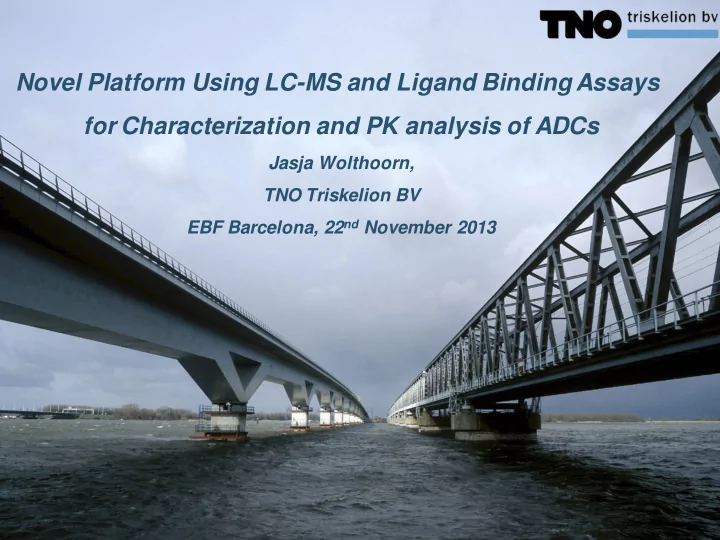

Novel Platform Using LC-MS and Ligand Binding Assays for Characterization and PK analysis of ADCs Jasja Wolthoorn, TNO Triskelion BV EBF Barcelona, 22 nd November 2013
THE DEVELOPMENT OF LARGE MOLECULES Recombinant Therapeutic Novel proteins Antibodies scaffolds Antibody - Biosimilars/ Drug Biobetters Conjugates
THE CYTOTOXIC DRUG Cytotoxic drugs very efficient but unspecific – Off-target effects Drug Mechanism Doxorubicin Inhibit DNA religation, leading to DNA double-strand breaks derivatives Maytansinoids; Prevent tubulin polymerization Auristatins Calicheamicins Cause double-strand DNA breaks CC-1065 Induces adenine alkylation Duocarmycins Break down adenine-specific molecules in the DNA structure Anthracyclines Inhibit DNA and RNA synthesis by intercalating between base pairs, preventing replications
THE MONOCLONAL ANTIBODY Therapeutic antibodies in oncology – Very specific/targeted, But efficacy was lower than expected
THE LINKER Criteria for linker in ADC: • Stable in blood • Able to release effector drug at target
EXAMPLES CURRENT LINKERS Linker Release Mechanism Hydrazone degradation in acidic compartments within the cytoplasm Peptide enzymatic hydrolyzed by lysosomal proteases such as cathepsin B Disulfide Cleavable through disulfide exchange with an intracellular thiol, such as glutathione Thioether Nonreducible and designed for intracellular proteolytic degradation Hydrophilic improve activity against multidrug resistant cells and carry a higher maytansinoid load DNA alkylator DNA-specific binding that increases reactivity, deactivates the cytotoxic, and reactivates only after the cytotoxic is cleaved Release mechanism linker – drug will impact in vivo behavior
ANTIBODY-DRUG CONJUGATE Antibody Cytotoxic drug Linker Combining the specificity of a mAb with the efficacy of a cytotoxic drug
BASIC MECHANISM ADCS http://www.seattlegenetics.com/adc_technology
OFF-TARGET EFFECTS Target independent Target dependent toxicity via Mannose toxicity of normal binding receptor cells (e.g. Her2) (glycosylation mAb) Premature release of drug
BIOANALYSIS Why is bioanalysis assessment of ADCs challenging?
BIOANALYSIS • Heterogeneity – more than one linker attached to mAb – varying drug-to-antibody ratio (DAR) Biotransformation – dynamic in vivo behavior •
WHAT TO EXPECT IN VIVO? free drug ADC mAb linker metabolites mAb + linker drug + linker
WHAT TO EXPECT IN VIVO? Which of these species is responsible for safety and efficacy?
BIOANALYSIS Typical approach to measure ADCs in matrix is multi- disciplinary: Linker Definition Assay type DAR ≥ 0 Total LBA antibody DAR ≥ 1 Conjugated LBA antibody Antibody- Total small molecule drug Affinity LC-MS/MS, conjugated conjugated to antibody LBA drug Free drug Unconjugated drug in circulation LC-MS/MS Total drug Conjugated & unconjugated drug LC-MS/MS
CONJUGATED AB DAR ≥ 1 Labelled anti-Fc antibody ADC Coated Anti-toxin antibody
TOTAL MAB DAR ≥ 0 Labelled anti-mAb ADC Coated Anti-Fc antibody
IMPROVING SPECIFICITY ASSA Y Use of anti-idiotypic reagents Anti-idiotypic = structure directed against the idiotopes Idiotopes: : unique set of antigen determinants anti-idiotypic antibody anti-idiotypic Fab fragment
TOTAL MAB WITH ANTI-IDS Labelled anti-mAb ADC Anti-ID antibody
TOTAL MAB WITH ANTI-IDS Labeled Anti-ID Fab ADC Anti-ID Fab
MULTI-DISCIPLINARY APPROACH Molar Concentration Total antibody assay LBA Conjugated antibody assay LBA Free Drug LC-MS Time Total antibody - Conjugated antibody = deconjugated Ab Information gained: average ADC in vivo fate/ no DAR distribution
BIOANALYSIS Problem ligand binding assay: • Reference standard may not be appropriate for quantification of analytes in vivo • Possible solution: calibrator with most anticipated DAR form (engineered homogenous ADC) • High payload (drug) may interfere with assay (steric hindrance)
BIOANALYSIS Problem LC-MS • Measurement based on fixed mass (e.g. intact drug alone) • Only a fraction of the cytotoxic drug may be measured due to interaction with matrix components or linker partially attached to drug – most dominant form of released drug may not be measured • Free drug concentration normally very low (~ 1%)
NOVEL BIOANALYSIS APPROACH Combine LC-MS with immuno pull down/ affinity capture - Opportunity to measure ADCs and their biotransformation in vivo over time
GENERIC CAPTURE & LC-MS/MS Generic: capture antibody (unspecific with Protein A/G), cleave drug/digest and measure on peptide level LC-MS/MS detection Linker cleavage/ ADC digestions step ADC and Endogenous IgG Capture by Protein A (resin) Still no DAR distribution!
GOAL – MEASURE DAR DISTRIBUTION Time 1 7 21 (days) 25
STEP 1: SPECIFIC AFFINITY CAPTURE + serum ADC Beads coated with target & removal of beads Magnetic separation Injection intact ADC into LC-MS
IMPROVING SPECIFICITY Beads coated with anti-idiotypic antibodies
STEP 2: LC-MS OF INTACT ADC representativeTIC of ADC (DAR 0-2) in rat plasma deconvolution
WHICH APPROACH AT WHICH STEP? Average DAR DAR distribution + Generic Affinity capture/ LBA with Capture LC-MS digest & Anti- (nano) LC-MS LC-MS Free drug idiotypic reagents LBA with Generic reagents R&D Preclinics Clinics
THANK YOU FOR YOUR ATTENTION
Recommend
More recommend